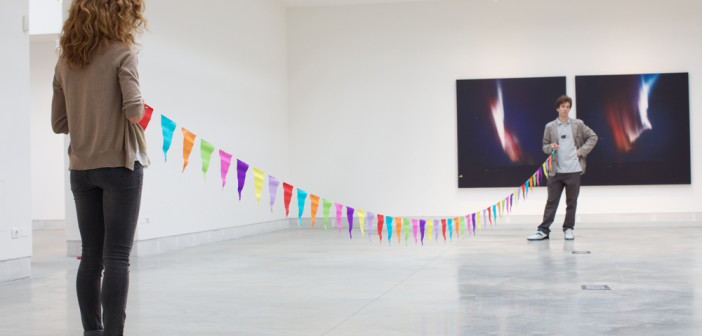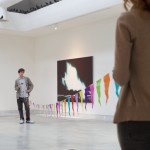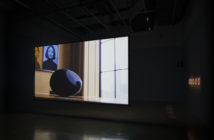The phrases "never talk to strangers" and "stranger danger" are so ingrained within our culture that they’ve become part of our lexicon. Amalia Pica knows this all too well, having lived in Argentina at a time when the country was slowly emerging from a military dictatorship that engendered fear and repression among its citizens and resulted in the disappearance of hundreds of people. Interested in the social acts of listening and technologies of mass communication, silence is very much part of Amalia Pica’s work, currently on view until April 7 at the List Visual Arts Center at MIT.
In the performance Strangers (2008), performed throughout the duration of her exhibition at the List, two people who have never met before hold a string of bunting for "hours at a time." When Strangers was performed at ILLUMinations at the 54th International Art Exhibition of the Venice Biennale in 2011, the participants were not allowed to speak to one another, but I am told that upon seeing the galleries at MIT, Pica opted for experimentation and instructed that participants be allowed to speak.
When I visited the museum, I spoke with both participants and was told that while they attempted to speak with one another, the attempt was futile. The distance of the string of bunting—thirty three feet from end to end—coupled with the hustle and bustle of a Thursday night art viewing scene, made it difficult to hear one another.
Distance is a concept present in much of Amalia Pica's work. "The exploration of this distance has led me to wonder about the need for an audience, the search for a public voice, and notions of cultural intimacy which I hope can be the space in which we come together with strangers in a loving or happy manner, despite the distance not being that of physical intimacy but not only determined by national identity," says Pica in an interview published in the exhibition’s catalogue with curators João Ribas and Julie Rodrigues Widholm. "This is the potential I see in the celebratory to generate a kind of distant love or social glue—hence my use of bunting, garlands, confetti, and fiesta lightbulbs as elements I go back to over and over again."
It is fitting that the performance takes place surrounded by confetti glued onto the gallery’s cement floor and Outside, Inside and Across (2006/2012), a highly festive sculptural work made of fiesta lightbulbs—reminiscent of Felix Gonzalez-Torres’ "Untitled" (Last Light)—which, as Stephanie Cardon writes in her review of the exhibition, are among the works that "leave one with the impression that the music has stopped, the party has ended or moved on without us."
In Strangers, ones does get the impression that the party has ended. The distance between the two is long enough to discourage participants from speaking with one another, yet Amalia Pica reminds us that we’re all strangers united by a common thread. And while we’re told that talking to strangers can lead us into danger, how else are we to make friends and acquaintances if we don't talk with people we don’t know?
In this day and age where social media has replaced in person communication, Strangers evokes that exciting wonder and thrill we first get when we talk to people we're unfamiliar with. It also makes us aware of the non-verbal signals present with one on one communication: eye contact, glancing, hands on the hips, hands clenched or closed, jiggling legs and many other signals that tell people how we're feeling about ourselves and others.
Speaking with one of the participants in this performance, I was told that standing in a gallery holding a string of bunting made her more aware of her surroundings and made her think about her role in relation to other works, visitors and her co-participant. IfStrangers doesn't evoke any thrill and wonder in you, it'll at least make you smile as it did to several visitors on the day I experienced it. You've only got a few more days to check this performance out before the exhibition travels to the Museum of Contemporary Art Chicago from April 27 through August 11, 2013.
- Amalia Pica, Strangers, 2008 Courtesy of the artist
- Amalia Pica, Strangers, 2008 Courtesy of the artist
Members of the MIT and local communities perform Strangers every Tuesday 12:30-2:30 pm, Thursday 5:30-7:30 pm, andSatuday 1:00-3:00 pm through the duration of the exhibition.
Amalia Pica is co-organized by the MIT List Visual Arts Center, and the Museum of Contemporary Art Chicago. The exhibition was co-curated by João Ribas, Curator, MIT List Visual Arts Center, and Julie Rodrigues Widholm, Pamela Alper Associate Curator at MCA Chicago.
The exhibition is on view at MIT List Visual Arts Center until April 7, 2013 and will be at the MCA Chicago from April 27—August 11, 2013.






